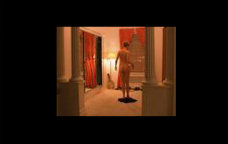Home
Gallery
Prints
Articles
About
Contact
CHRIS BENNETT
Artist
Articles

STANLEY KUBRICK - Thoughts on Eyes Wide Shut
Eyes Wide Shut, along with 2001 A Space
Odyssey, is in my view
Stanley Kubrick's greatest film. Yet 2001 enjoys a huge cult
following whereas EWS has not generally received such critical
acclaim to date. Barry Lyndon is also greatly overlooked, which
may have something to do with how it willfully undermines its
own plot developments; you are constantly told things by the
narrator ahead of the on-screen story. This is of course for
artistic
reasons, since the film is in no small measure about fate; it's as
if
the film would play perfectly well backwards. It is also a film
where you feel 'distanced' from everything all the time; again
reinforcing the feeling that we, the audience, are the eyes of a
disinterested 'fate', witnessing the course of events.
In the case of Eyes Wide Shut, although the
surface of the film in
terms of drama and pace is, like Barry Lyndon, extremely quiet, it
is so for very different reasons. Here, it is to enable the myriad
connections and parallels in the film to breathe freely and allow
them to 'dawn on you.' This is in keeping with the film's theme
involving the vicissitudes of a psychological state. Here are a
couple of very simple examples of what I mean:
The first shot we see in EWS is of Nicole
Kidman's dress falling to
the floor revealing her slim naked body. The same image is
paralleled later during the orgy sequence when Bill Harford
(Kidman's on-screen husband) sees the same image, but
multiplied in the form of a circle of 'hookers' who let their black
capes fall to the ground revealing naked bodies identical to
that of his wife. We are never sure if we are witnessing Bill's
fantasy and therefore what this reveals about his unconscious
view of his spouse or, conversely, his unconscious view of
prostitutes.
The second example is a little more complex,
but I will mention
a simple element of it: the various events and situations of the
orgy are strangely reminiscent, as if in a dream, of the party at
Zeigler’s grand house and also the fancy dress shop where Bill
hires his outfit for his nocturnal adventure. In both scenes we
are privy to a disclosure, an unmasking, explicit in Bill’s literal
unmasking at the orgy and implicit in the discovery by Mr Milic
of his daughter’s antics in the hire shop. It is with shock that we
recognise the direct parallel this has with the incident at
Ziegler’s party, where Bill himself is the one who ‘unmasks’ his
host by virtue of his professional services as a doctor being
required at short notice. In these three variants of the same
situation Bill is seen as witness, a bystander and perpetrator of
the same ‘crime’.
These are just two among hundreds of such occurrences in the
fabric of this film which, as you uncover them, encourage you
to see everything as a sort of cinematic hologram of a state of
mind.
There is something else I would like to mention about this film;
something that had an immediate and visceral effect on me was
the way the film creates a sense of a continuous and unified
‘world’. Whether it is day or night, whether we are on the wet
streets outside, or at the palace orgy, Ziegler’s mansion, the
prostitute’s tiny bed-sit, the hospital, Bill and Alice’s apartment
or a jazz club, everything is infused with the same ‘DNA’
regarding its mood, atmosphere and ‘tone’. In this way it
closely resembles 2001 A Space Odyssey which uses a precise
sense of environment as the main engine driving its emotional
language. In fact the distinction between the two films could
be that 2001 makes the unfamiliar familiar, whereas Eyes Wide
Shut makes the familiar unfamiliar.
The sense, on screen, of the deep connectivity between all the
things that pass before our eyes means we witness the process
whereby a state of mind is made concrete. The structural web
binding the film together forms a labyrinth through which our
own mind passes, casting it temporarily into a precise
psychological state governed by the act of editing. The
unconscious way we deal with our own memories and their
psychological interpretation, the architecture of our psyche, is
akin to the shaping of the components that make a film by way
of set design, actors, photography, sound and time and is,
particularly in the form of Eyes Wide Shut, its perfect metaphor.
Chris Bennett 2008